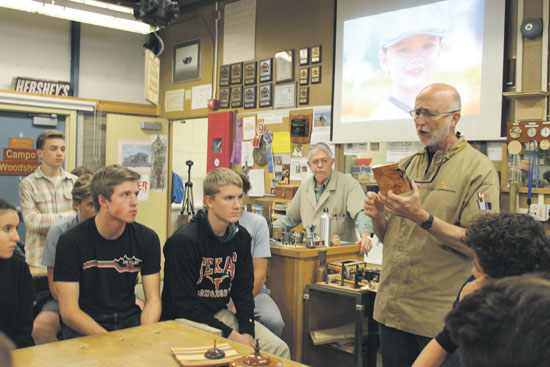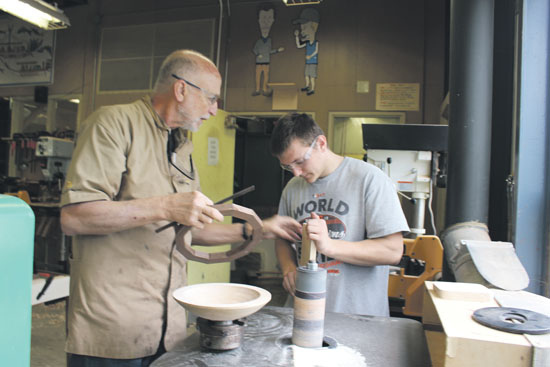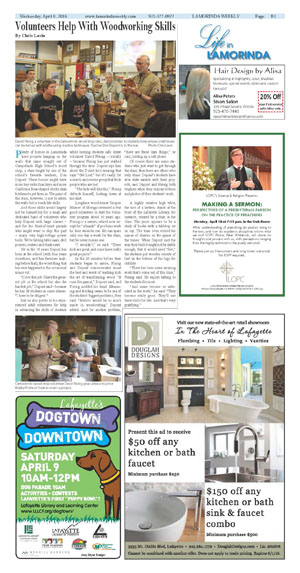|
|
Published April 6th, 2016
|
Volunteers Help With Woodworking Skills
|
|
| By Chris Lavin |
 |
| David Fleisig, a volunteer in the Campolindo wood shop class, demonstrates to students how unique small boxes can be turned with a lathe using creative techniques. Teacher Don Dupont is in the rear. Photo Chris Lavin |
Plenty of homes in Lamorinda have projects hanging on the walls that came straight out of Campolindo High School's wood shop, a class taught by one of the school's favorite teachers, Don Dupont. These houses might have more key racks than keys and more California Bear-shaped clocks than kitchens to put them in. The point of the class, however, is not to adorn the walls but to teach life skills.
 And those skills would largely not be learned but for a small and dedicated band of volunteers who help Dupont with large classes - and for the feint-of-heart parents who might want to skip this part - many very high-voltage power tools. We're talking table saws, drill presses, routers and blade saws.
And those skills would largely not be learned but for a small and dedicated band of volunteers who help Dupont with large classes - and for the feint-of-heart parents who might want to skip this part - many very high-voltage power tools. We're talking table saws, drill presses, routers and blade saws.
 Yet in the 16 years Dupont has been at the school (with four years elsewhere, and fine-furniture making before that), the worst thing that has ever happened is the occasional minor cut.
Yet in the 16 years Dupont has been at the school (with four years elsewhere, and fine-furniture making before that), the worst thing that has ever happened is the occasional minor cut.
 "I love this job. I have the greatest job in the school but also the hardest job," Dupont said - because he has 28 students in some classes. "I have to be diligent."
"I love this job. I have the greatest job in the school but also the hardest job," Dupont said - because he has 28 students in some classes. "I have to be diligent."
 But he also points to his experienced adult volunteers for help in advancing the skills of students while keeping students safe. Enter volunteer David Fleisig - literally - because Fleisig has just walked through the door. Dupont rips him about the T-shirt he's wearing that says "Get Lost," but it's really for a search-and-rescue group that finds people who are lost.
But he also points to his experienced adult volunteers for help in advancing the skills of students while keeping students safe. Enter volunteer David Fleisig - literally - because Fleisig has just walked through the door. Dupont rips him about the T-shirt he's wearing that says "Get Lost," but it's really for a search-and-rescue group that finds people who are lost.
 "The kids will like this," Fleisig defends himself, looking down at his shirt.
"The kids will like this," Fleisig defends himself, looking down at his shirt.
 Longtime wood-turner Jacques Blumer of Moraga recruited a few good volunteers to start the volunteer program about 10 years ago. Fleisig is a lawyer, retired now except for "a bunch" of pro bono work he does when he can. He can spare only one day a week for the class, but he never misses one.
Longtime wood-turner Jacques Blumer of Moraga recruited a few good volunteers to start the volunteer program about 10 years ago. Fleisig is a lawyer, retired now except for "a bunch" of pro bono work he does when he can. He can spare only one day a week for the class, but he never misses one.
 "I wouldn't," he said. "These kids are great, and some have really great projects."
"I wouldn't," he said. "These kids are great, and some have really great projects."
 In the 20 minutes before their students began to arrive, Fleisig and Dupont commiserated about the best and worst of teaching kids the art of transforming wood. "It runs the gamut," Dupont said, and Fleisig nodded his head. Measuring and dividing seems to be one of the students' biggest problems, they said. "Metrics would be so much easier in wood-cutting," Dupont added. And for another problem, "there are these darn things," he said, holding up a cell phone.
In the 20 minutes before their students began to arrive, Fleisig and Dupont commiserated about the best and worst of teaching kids the art of transforming wood. "It runs the gamut," Dupont said, and Fleisig nodded his head. Measuring and dividing seems to be one of the students' biggest problems, they said. "Metrics would be so much easier in wood-cutting," Dupont added. And for another problem, "there are these darn things," he said, holding up a cell phone.
 Of course there are some students who just want to get through the class; then there are others who truly shine: Dupont's students have won state awards with their projects, and Dupont and Fleisig both brighten when they display ribbons and photos of their students' work.
Of course there are some students who just want to get through the class; then there are others who truly shine: Dupont's students have won state awards with their projects, and Dupont and Fleisig both brighten when they display ribbons and photos of their students' work.
 A highly creative high table, the size of a lectern, stands at the front of the Lafayette Library, for instance, created by a team in the class. The piece appears to be a stack of books with a tabletop set on top. The team even etched the names of classics on the spines of the tomes. When Dupont said the way they built it might not be stable enough, that it would need "feet," the students put wooden cutouts of feet on the bottom of the legs for stability.
A highly creative high table, the size of a lectern, stands at the front of the Lafayette Library, for instance, created by a team in the class. The piece appears to be a stack of books with a tabletop set on top. The team even etched the names of classics on the spines of the tomes. When Dupont said the way they built it might not be stable enough, that it would need "feet," the students put wooden cutouts of feet on the bottom of the legs for stability.
 "There has been some amazing work that's come out of this class," Fleisig said. He enjoys talking to the students the most.
"There has been some amazing work that's come out of this class," Fleisig said. He enjoys talking to the students the most.
 "And some become so interested in the work," he said. "They become really good. They'll use these skills for life. And that's very gratifying."
"And some become so interested in the work," he said. "They become really good. They'll use these skills for life. And that's very gratifying."


|
 |
| Campolindo wood shop volunteer David Fleisig gives advice to junior Bobby Poole on how to orient a project. |
|
|
|
|
|
|
| |
|
|
|
|




